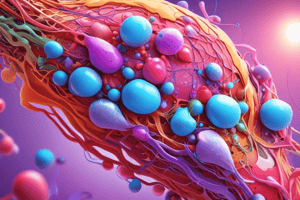Podcast
Questions and Answers
What is a key feature of all endocrine glands?
What is a key feature of all endocrine glands?
- They use ducts to transport hormones
- They secrete neurotransmitters
- They have direct physical connections to target tissues
- They secrete hormones (correct)
Why are endocrine glands referred to as 'ductless' glands?
Why are endocrine glands referred to as 'ductless' glands?
- Because they have direct physical connections to target tissues
- Because they secrete neurotransmitters
- Because they must use the blood to transport hormones to target tissues (correct)
- Because they use ducts to transport hormones
Which system works in conjunction with the endocrine system to control overall body function and regulation?
Which system works in conjunction with the endocrine system to control overall body function and regulation?
- Nervous system (correct)
- Skeletal system
- Muscular system
- Circulatory system
How do hormones recognize their target tissues?
How do hormones recognize their target tissues?
Which of the following is NOT an endocrine gland as mentioned in the text?
Which of the following is NOT an endocrine gland as mentioned in the text?
What is the main concept behind hormone-receptor interactions?
What is the main concept behind hormone-receptor interactions?
What is the primary method by which hormones produce specific responses in the body?
What is the primary method by which hormones produce specific responses in the body?
How do endocrine disorders typically manifest?
How do endocrine disorders typically manifest?
What is the effect of aging on the endocrine system?
What is the effect of aging on the endocrine system?
'Negative feedback' control mechanisms for hormone synthesis refer to which of the following?
'Negative feedback' control mechanisms for hormone synthesis refer to which of the following?
When examining a patient's fingernails, what abnormalities may suggest thyroid gland problems?
When examining a patient's fingernails, what abnormalities may suggest thyroid gland problems?
What type of skin changes may reflect a specific endocrine dysfunction?
What type of skin changes may reflect a specific endocrine dysfunction?
Which imaging method is the most sensitive for viewing the pituitary gland?
Which imaging method is the most sensitive for viewing the pituitary gland?
What is the purpose of performing suppression tests in endocrine evaluations?
What is the purpose of performing suppression tests in endocrine evaluations?
What is the significance of assessing changes in energy levels when examining a patient?
What is the significance of assessing changes in energy levels when examining a patient?
Flashcards are hidden until you start studying
Study Notes
Hormone-Receptor Actions
- Hormone-receptor actions work in a "lock and key" manner, where only the correct hormone can bind to and activate the receptor site.
- Binding a hormone to its receptor causes the target tissue to change its activity.
- Hormones produce specific responses even though they circulate throughout the body.
Disorders of the Endocrine System
- Disorders of the endocrine system are related to either an excess or a deficiency of a specific hormone or to a defect at its receptor site.
- The onset of these disorders can be either slow and insidious or abrupt and life-threatening.
Control of Cellular Function
- The control of cellular function by any hormone depends on a series of reactions working through negative feedback control mechanisms.
- When a condition starts to move away from the normal range, secretion of the hormone capable of causing the correct response is stimulated until the need or demand is met.
- As the correction occurs, hormone secretion decreases and may halt.
Complex Interactions
- Some hormones have more complex interactions, with a series of reactions in which more than one endocrine gland, as well as the final target tissue, is stimulated.
- The effects of aging on the endocrine system vary but usually result in reduced glandular function and decreased hormone secretion.
Assessment Methods
- Endocrine problems can disturb any health pattern, with the most commonly affected patterns being nutrition, metabolic, activity, elimination, sleep, and sexual and reproductive functions.
- Age and gender of the patient provide baseline assessment data.
Anatomy and Physiology Review
- The endocrine system is made up of glands in many tissues and organs in a variety of body areas.
- A key feature of all endocrine glands is the secretion of hormones.
- Hormones are natural chemicals that exert their effects on specific tissues known as target tissues.
- Target tissues are usually located some distance from the endocrine gland, with no direct physical connection between the endocrine gland and its target tissue.
Patient Assessment
- Assess the patient for a history of endocrine dysfunction and for manifestations that could indicate an endocrine disorder, especially those that have required hospitalization.
- Ask the patient about other family members with endocrine disorders because some endocrine problems have a genetic component.
- Ask the patient what prescribed and over-the-counter drugs were or are taken on a regular basis because some drugs can alter endocrine function.
Laboratory Tests
- Laboratory tests are an essential part of the diagnostic process, including tests of blood, urine, and saliva.
- Underactivity of an endocrine gland may require stimulation to determine whether the gland is capable of normal hormone production.
- Suppression tests are used when hormone levels are high or in the upper range of normal.
- An assay measures the level of a specific hormone in blood or other body fluid.
Imaging Studies
- Anterior, posterior, and lateral skull x-rays may be used to view the sella turcica, the bony pocket in the skull where the pituitary gland rests.
- Magnetic resonance imaging with contrast is the most sensitive method of imaging the pituitary gland, although computed tomography (CT) scans can also evaluate.
- The thyroid, parathyroid glands, ovaries, and testes are evaluated by ultrasound.
- CT scans are also used to evaluate the adrenal glands, ovaries, and pancreas.
Studying That Suits You
Use AI to generate personalized quizzes and flashcards to suit your learning preferences.




